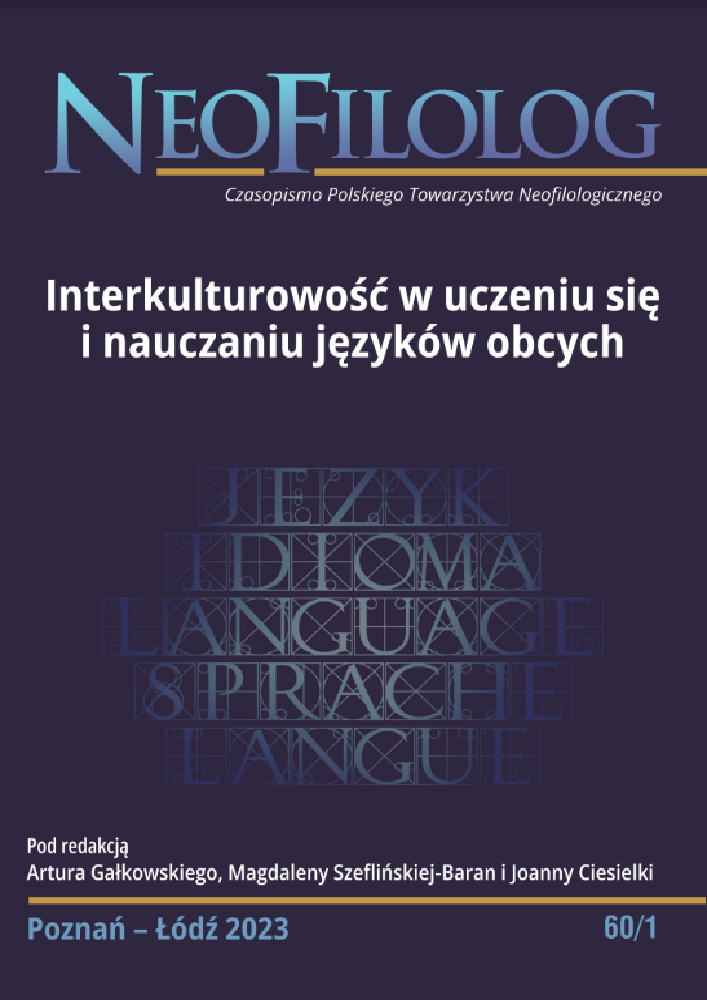Abstract
Recognizing that appellative systems are subjected to particular sociocultural codifications, through this study we try to verify whether the didactic presentation of the address forms, and in particular of the address forms of the Spanish-speaking world, is not limited only to a formal schematization, overlooking the interpretative clues about the scope of use and sociopragmatic conventions. Carrying out the analysis of a few manuals of Spanish as a foreign language, we try to find out what functional values acquire the address forms in the proposed contextualizations. In our approach, we take into account both pronominal and nominal address forms. Similarly, we propose to investigate the question of conceptualizations through which different methods of Spanish as a foreign language reflect the notional contents linked to the contexts of formality and proximity.
Literaturhinweise
Baran M. (2010), Emotividad y convención sociopragmática. Una contribución al estudio del ethos comunicativo de la comunidad hispanohablante peninsular. Łódź: Wydawnictwo Uniwersytetu Łódzkiego.
Baran M. (2012), Formas nominales y pronominales de tratamiento: perspectivas de estudios contrastivos en el ámbito sociopragmático. “Studia Iberystyczne”, n° 11, pp. 27-56. DOI: https://doi.org/10.12797/SI.11.2012.11.04
Blas Arroyo J. L. (2005), Sociolingüística del español. Desarrollos y perspectivas en el estudio de la lengua española en contexto social. Madrid: Cátedra.
Bravo D. (2003), Actividades de cortesía, imagen social y contextos socioculturales: una introducción, (en:) Bravo D. (ed.), Actas del Primer Coloquio del Programa EDICE: Perspectiva no etnocentrista de la cortesía: identidad sociocultural de las comunidades hispanohablantes. Stockholms: Stockholms Universitet, pp. 98-107.
Brown P., Levinson S. (1987), Politeness. Some Universals in Language Usage. Cambridge: Cambridge University Press. DOI: https://doi.org/10.1017/CBO9780511813085
Brown R., Gilman A. (1960), The pronouns of Power and Solidarity, (en:) Sebeok T. A. (ed.), Style in Language. New York: Wiley, pp. 253-276.
Fontanella de Weinberg M. B. (1999), Sistemas pronominales de tratamiento usados en el mundo hispánico, (en:) Bosque, I., Demonte, V. (eds.), Gramática Descriptiva de la Lengua Española. Madrid: Espasa Calpe, pp. 1400-1425.
Gassó M. J. (2009), El voseo rioplatense en la clase de español. “redELE”, n° 9, pp. 1-26.
Granvik A. (2007), Formas de tratamiento e interferencia. Estudio sobre el uso de las formas de tratamiento españolas por parte de portugueses nativos residentes en Madrid. “Revista de Filología Románica”, n° 24, pp. 221-250.
Gumperz J. J. (1982), Discourse strategies. Cambridge: Cambridge University Press. DOI: https://doi.org/10.1017/CBO9780511611834
Kerbrat-Orecchioni C. (1995), La construction de la relation interpersonnelle: quelques remarques sur cette dimension du dialogue. “Cahiers de Linguistique Française”, n° 16, pp. 69-88.
Kerbrat-Orecchioni C. (2005), Le discours en interaction. Paris: Armand Colin.
López López G., Martínez Franco S. P. (2022), Los significados sociales de las formas de tratamiento ‘tú’ y ‘usted’ en Bogotá, Colombia y sus implicaciones en la enseñanza de español como lengua extranjera. “Revista Signos. Estudios de Lingüística”, n° 55(108), pp. 417-450. DOI: https://doi.org/10.4067/S0718-09342022000100417
Mas Álvarez I. (2014), Formas de tratamiento y enseñanza del español como lengua extranjera. “redELE”, n° 26, pp. 1-16. DOI: https://doi.org/10.14483/udistrital.jour.calj.2014.1.a02
Pop L. (2006), Peut-on parler du style interjectif ? Le cas du roumain. “Langages”, n° 161, pp. 24-36. DOI: https://doi.org/10.3917/lang.161.0024
Roselló Verdeguer J. (2018), Las formas de tratamiento en el corpus PRESEEA-Valencia. Un estudio sociolingüístico. “CLAC (Círculo de Lingüística aplicada a la comunicación)”, n° 76, pp. 241-260. DOI: https://doi.org/10.5209/CLAC.62507
Sánchez Avendaño C. (2004), Variación morfosintáctica y enseñanza del español como lengua extranjera: reflexiones de un lingüista metido a profesor. “Filología y Lingüística”, n° XXX (2), pp. 131-154. DOI: https://doi.org/10.15517/rfl.v30i2.4442
Wolarska A. (2004), Pragmalingwistyczna analiza form adresatywnych w języku polskim i hiszpańskim (rozprawa doktorska). Poznań: Uniwersytet im. Adama Mickiewicza.
Corpas J., García E., Garmendia A., Soriano C. (2005), Aula Internacional 1, Barcelona: Difusión.
Corpas J., García E., Garmendia A., Soriano C. (2015), Aula Internacional 2, Barcelona: Difusión.
Corpas J., Garmendia A., Sánchez N., Soriano N. (2007), Aula Internacional 4, Barcelona: Difusión.
Encina A., Corpas J., Gambluch C. (2015), Diverso 1, Madrid: SGEL.
Martín Peris E., Sánchez Quintana N., Sans Baulenas N., Vañó Aymat A. (2005), Gente 2, Barcelona: Difusión.
Martín Peris E., Sans Baulenas (2005), Gente 3, Barcelona: Difusión.
Nieto-Kuczyńska D., Nieto-Rasiński D. E. (2012), Arcoíris A1-A2. Podręcznik do nauki języka hiszpańskiego, Wrocław: Przystanek EDU S. C.
Sans N., Martín Peris (2013), Gente hoy 1, Barcelona: Difusión.
Lizenz
Copyright (c) 2023 Marek Baran

Dieses Werk steht unter der Lizenz Creative Commons Namensnennung - Keine Bearbeitungen 4.0 International.
Autoren:
Die Autoren der zur Veröffentlichung in der Zeitschrift Neofilolog angenommenen Texte sind verpflichtet, den Vertrag über die Erteilung einer kostenlosen Lizenz für die Werke mit der Verpflichtung zur Erteilung einer Sublizenz CC auszufüllen, zu unterzeichnen und an die Adresse der Redaktion zurückzusenden.
Gemäß Vertrag erteilen die Autoren auf die in der Zeitschrift Neofilolog veröffentlichten Texte der Adam-Mickiewicz-Universität in Poznań eine nicht exklusive und kostenlose Lizenz und erlauben die Verwendung der Sublizenz Creative Commons Attribution-NoDerivatives 4.0 International (CC BY-ND 4.0).
Die Autoren behalten das Recht zur weiteren freien Verfügung über das Werk.
Benutzer:
Interessierte Onlinebenutzer dürfen die seit 2017 veröffentlichten Werke unter folgenden Bedingungen nutzen:
- Anerkennung der Urheberschaft - die Verpflichtung, zusammen mit dem verbreiteten Werk Informationen über die Urheberschaft, den Titel, die Quelle (Links zum Originalwerk, DOI) und die Lizenz selbst bereitzustellen;
- ohne Schaffung abgeleiteter Werke - das Werk muss in seiner ursprünglichen Form erhalten bleiben, ohne Zustimmung des Autors dürfen keine Studien, beispielsweise Übersetzungen, verbreitet werden.
Die Urheberrechte aller veröffentlichen Texte sind vorbehalten.
Sonstige:
Die Adam-Mickiewicz-Universität in Poznań behält das Recht auf die Zeitschrift als Gesamtheit (Layout, Grafik, Titel, Umschlagsprojekt, Logo usw.).

